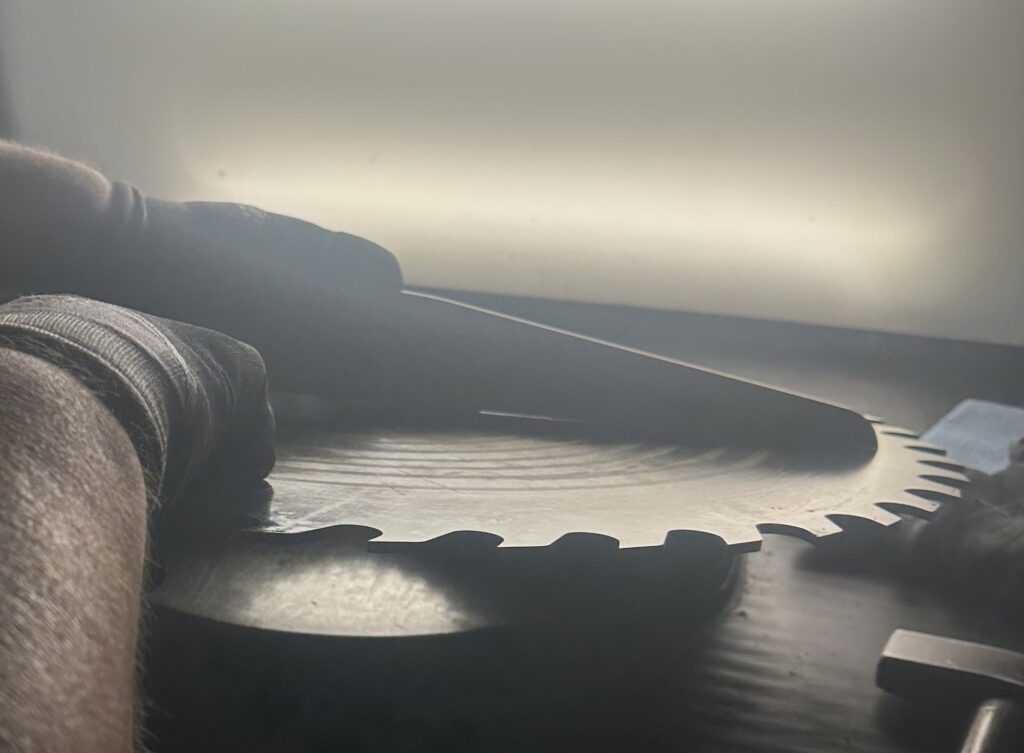
Features
Opinions
Equipment
Sawmilling
Saw Filing 101: The guided circle saw
July 3, 2023 By Paul Smith
 Photo: BID Group.
Photo: BID Group. The guided circle saw is one tough tool when put up correctly, properly tensioned and of course used for the right job. Weighing in at under 20 pounds, with an average diameter of 20 inches and a thickness of .090 or less, it’s difficult to see how it does the job for which it is intended. How can one expect it to cut through and stand up to an average log weighing around 1,200 pounds at feed speeds of 400 to 700 feet per minute?
Well fortunately for our industry, a well-designed and well-maintained circle saw can cut through a log as if it were butter. Yes, my fellow sawfilers and colleagues, we may put more design, planning and effort into making a saw perform its job than the proverbial rocket science necessary to send a rocket into space.
Allow me to touch on a few things that are in play with this phenomenon.
RPMs: The circle saw must be operating at the proper RPM. This allows the saw body to stand up and not “wobble or snake” through the wood. Mills want a straight cut and that is what you get with the right tension, proper tooth geometry and correct RPM. Make sure your saw manufacturer is provided with the correct RPM when designing your circle saw. If machinery in the changes always update your saw provider.
Guides: The guides are the saws best friend or worst enemy. The circle saw should never touch the guide but slip through a thin film of saw lubricant. Because the saw is running between the guides in a very tight space (.002-.003 per side), improperly designed or maintained guides can cause the saw to overheat and lose tension, lay-over, cut bad lumber and cause the mill unscheduled saw changes. Like the saws, a saw guide has critical tolerances that must be maintained. Each run time they should be checked for damage or unusual wear. Changes in saw plate thickness will affect guides. Make sure to consider how a plate thickness change will affect your guides and communicate this with both saw and guide manufacturers or your sales rep.
Machinery: The machine centre that the saws and guides are in must be mentioned if we are to be successful in producing grade lumber products. By documenting upkeep and maintenance done on the machine centre, it’s possible to make good decisions on why saws are not running to the best of their design and help determine when and what maintenance needs to be done on the machine itself. Alignment and wear and tear must be addressed when saws and guides aren’t the issue.
Data: I recently spent some time with a group of mill professionals and was impressed at the data they had at the touch or swipe of a device. These new sawing systems give mill owners, operators and yes, filers DATA. So, I suggest we use it. Understanding and knowing what happened in the past allows your choices in the future to be successful. Choices that seemed difficult or didn’t pan out in the past can be addressed once data is reviewed and variables identified. The best way to ensure success during each saw run or rocket launch is to document and learn from the success and failures of the past.
Tracking: If part of your job involves reviewing data, you’ve probably used terms like tracking, drilling down, or unique identifiers. This is the main reason we at SSS/BID Group etch each circle saw we manufacture with an identification number. This number allows both our team and the mill to keep up with the saw’s history, including number of times the saw has been benched, retipped and sharpened. Knowing the history and how the saw(s) ran in the past gives us the knowledge and ability to know what to expect in the future. These identifiers can help track when variables such as hook or kerf are changed. SSS and the BID Group can help your mill with the equipment, tools, and software to accomplish successful sawing. If you are working with another professional saw company, I’m certain they can do the same.
Paul Smith is a saw filing consultant and founder of Smith Sawmill Service, now part of BID Group. You can reach him at Paul.Smith@bidgroup.ca.
Print this page